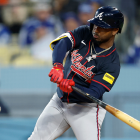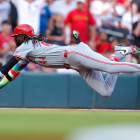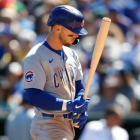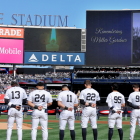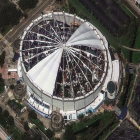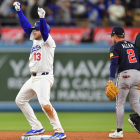
Defensive shifting isn't a new thing, as any good Ted Williams fan could tell you, but they are becoming more common with the increase in technology on the scouting front. In fact, noted defensive statistician John Dewan reports -- via the 2015 Bill James Handbook -- that there were 2,464 shifts in Major League Baseball in 2010 and that number rose to 13,296 last season. It's working, too, as Dewan notes that shifts saved 195 runs in 2014.
Let's break down a few shifty categories. The source for this is Dewan in the Bill James Handbook. For the complete rankings and data, see the book. It's a stat geek's dream.
Most shifts, AL
1. Astros, 1341
2. Rays, 824
3. Yankees, 780
Fewest shifts, AL
13. Mariners, 411
14. Angels, 107
15. Tigers, 66
Most shifts, NL
1. Pirates, 659
2. Brewers, 576
3. Cardinals, 367
Fewest shifts, NL
13. Marlins, 208
14. Nationals, 201
15. Rockies, 114
Most plate appearances against shifts
1. David Ortiz, 505
2. Ryan Howard, 453
3. Chris Davis, 400
4. Brandon Moss, 398
5. Brian McCann, 394
Oddities/Notes
•We can't draw any firm correlation between good defensive teams and the number of times they shift. It's all over the board. Using defensive runs saved (my preferred method), the top five defenses in baseball last season were the Reds, Cardinals, Orioles, Royals and Padres. The Reds were 11th in the NL in shifts, but the Cardinals were third. The Orioles were fourth in the AL in shifts with the Royals being sixth. The Padres were eighth in the NL in shifts.
At the bottom, the Indians were the worst defensive team in baseball by almost every metric. They were eighth in the AL in shifts. The Twins and Tigers were also bad on defense and they didn't shift much. The Astros blew everyone away on shifts but were overall way below average on most defensive metrics.
•Generally speaking, though, Dewan reports that the more teams shift, the more runs they save that they otherwise wouldn't have saved. So even the very good defensive teams could stand to do more shifting, so long as they do their homework and do it correctly.
•Most players who were frequently shifted against had a better batting average on grounders and liners with no shift, sometimes considerably better -- like Carlos Santana, who hit .144 against shifts and .321 with no shift. Brandon Moss, though, hit .236 against the shift and .091 with no shift. It's a small sample issue, as he faced a shift in 88.1 percent of his plate appearances and, again, this only includes ground balls and line drives.
•Dewan reports that the league batting average is roughly 30 points lower against defensive shifts.
The bottom line is that if you have a problem with shifts, things aren't going to be getting any more desirable moving forward.
![[object Object] Logo](https://sportshub.cbsistatic.com/i/2020/04/22/e9ceb731-8b3f-4c60-98fe-090ab66a2997/screen-shot-2020-04-22-at-11-04-56-am.png)









